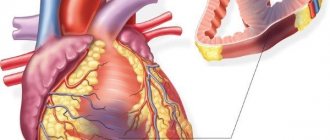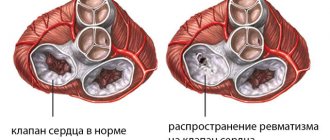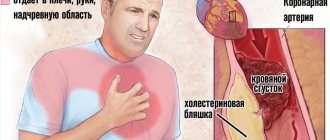In modern society, the rate of increase in the diagnosis of cardiac pathologies is increasingly observed, with the male half of the population leading in this “race”. Signs of coronary heart disease in men can be pronounced, vague or asymptomatic, but in any manifestation they can lead to death.
Cardiologists diagnose their patients with different forms of this cardiac pathology, which differ little in the manifestations of symptoms, and the factors that provoke the symptoms of coronary disease in any of its manifestations are the same.
Main forms of the disease
The main signs and symptoms of ischemic failures in the cardiac system are considered by experts to be forms of one ischemic disease.
Cardiologists include the following diseases as forms of cardiac ischemia:
- stable and unstable forms of angina;
- primary and recurrent myocardial infarction;
- post-infarction cardiosclerosis;
- heart failure of varying severity.
Signs of ischemic disease in patients of any gender appear against the background of impaired oxygen supply to the myocardium. These pathological processes, as a rule, arise and develop against the background of:
- atherosclerosis of the coronary arteries with subsequent narrowing of the lumen;
- spasm of arteries not affected by atherosclerosis;
- disturbances of blood microcirculation in the myocardium itself;
- increasing blood clotting activity.
Considering the fact that atherosclerosis develops in waves, but steadily, the symptoms of coronary artery disease are characterized by instability and alternating intensification and decrease in the degree of manifestation. The risk of increased pathological symptoms increases with increasing physical activity and exposure to nervous stress.
Clinical manifestations of the disease
Symptoms of IHD are largely determined by its form. The following clinical types of IHD are distinguished:
- angina pectoris (stable and unstable);
- myocardial infarction;
- sudden cardiac death;
- painless type;
- post-infarction cardiosclerosis;
- arrhythmia;
- cardiac conduction disturbance;
- acute and chronic heart failure.
IHD can occur in acute and chronic forms. Most often it occurs in waves with periods of exacerbation and remission. In men, this pathology is rarely asymptomatic. Common clinical manifestations of IHD include the following:
- pain in the heart area;
- dyspnea;
- increased and frequent heartbeat;
- malaise;
- feeling of fear;
- disturbance of consciousness;
- fainting;
- dizziness;
- headache;
- nausea.
Very rarely, all these symptoms appear in men at the same time.
Based on the clinical features of IHD, various forms of the disease are distinguished. The most clinically significant of these are the forms of the disease listed below.
- Stable exertional angina. It is characterized by the periodic occurrence of attacks of cardialgia, which, as a rule, are provoked by physical activity or the influence of another factor (for example, a stressful situation).
- Vasospastic angina (Prinzmetal). A distinctive feature of this form of IHD is that symptoms occur for no apparent reason, even with complete rest (for example, during sleep).
- Painless variant of angina pectoris. It is characterized by the course of the disease without significant clinical manifestations, in particular without attacks of pain. The existing symptoms are usually nonspecific - general weakness, a tendency to increased fatigue, and so on.
- Myocardial infarction. This form of the disease is a complication of coronary heart disease and is characterized by a prolonged (more than 10 minutes) painful attack of significant intensity. In addition, this form of the disease poses an immediate threat to the patient’s life.
- Heart failure. This form of the disease also refers to complications of coronary heart disease. Characteristic symptoms include progressive shortness of breath during exercise, as well as swelling of the lower extremities that increases throughout the day.
Ischemia is characterized by a wave-like course: calm periods are replaced by exacerbation of the pathology. For many years a person may not even suspect its existence. During this time, the disease takes on different forms.
One form of ischemic heart disease is angina pectoris. This manifestation leads to irreversible consequences - necrosis and death of heart cells. Angina pectoris is accompanied by the following symptoms:
Painful sensations. This is the first thing you should pay attention to. Features of pain with angina pectoris:- localized behind the sternum;
- lasts no more than 20 minutes;
- may subside on its own when the person calms down.
radiates to the shoulder or neck area;
Angina pectoris is paroxysmal in nature. The duration of the attack is about 5-7 minutes. To stop it, it is enough to take Nitroglycerin.
There are several stages of angina pectoris. Among them:
- Angina pectoris. It develops during physical exertion or emotional shock. In this case it can be:
- stable (there is a definition of the functional class);
unstable (new, progressive, postoperative, post-infarction).
The most dangerous form is unstable angina, especially if it tends to progress. This pathology develops even with minor stress on the heart and often leads to negative consequences (for example, a heart attack).
Risk factors for developing pathology
Symptoms of coronary heart disease, according to statistics, appear much more often in men than in the female half of the population. Therefore, the first important factor that provokes the manifestations of coronary disease is the so-called gender aspect: in men this disease is diagnosed twice as often as in the female half of the population. Experts attribute this to the fact that women have sufficient amounts of hormones in their bodies that block the development of atherosclerosis.
In addition, experts include the following factors for the occurrence of manifestations of coronary heart disease:
- age category over 45 years;
- hereditary predisposition to heart and vascular diseases;
- nicotine abuse (smoking more than 10-20 cigarettes per day);
- persistently high blood cholesterol levels over several months or years;
- symptoms of arterial hypertension;
- diabetes mellitus, insulin-dependent form;
- overweight;
- sedentary lifestyle.
Factors provoking coronary heart disease can act separately, but can also overlap each other, thereby increasing the possibility of the occurrence and manifestation of the pathological process.
Treatment methods
In order to confirm the presence of the disease, it is worth undergoing both regular and special checks and tests.
Medical examination. The doctor, independently or through tests, checks the condition of the person’s main organs by measuring blood pressure, monitoring the left ventricle for insufficiency, hypertrophy or atherosclerosis, listening to the lungs and finding wheezing.
Blood and urine tests. The first detects the number of red blood cells and white blood cells. The second confirms the data of the first analysis and establishes the level of proteins in the body.
Coagulogram. Since increased blood clotting is the main symptom of the disease, this procedure is necessary because it determines its level.
ECG. Aimed at studying the left ventricle: its size and work overloads.
EchoEkg. Analyzes the functioning of the heart as a whole using ultrasound, examines blood vessels and valves.
Coronary angiography. A subtype of x-ray aimed at the coronary artery. Searches for narrowings and other deformations.
Men are more susceptible to heart disease than women due to the presence of the hormone estrogen in the female body. Men aged 40 should take their health seriously, get rid of bad habits, play sports, and get more rest, because...
It is at this age that signs of the disease most often appear. Once every six months it is necessary to carry out a set of diagnostic procedures - this will help to identify the disease in the early stages and begin treatment.
Author of the article: Tatyana Semeiko
mirkardio.ru
When diagnosing coronary heart disease, the cardiologist’s actions are aimed at relieving the clinical manifestations of this pathology in the patient, as well as preventing the development of life-threatening conditions (heart attack, sudden cardiac death).
Treatment of myocardial ischemia includes:
- Developing a balanced diet, excluding excessively fatty foods from the usual menu, as well as products containing easily digestible carbohydrates (confectionery).
- Organization of the correct work and rest regime.
- Calculation of permissible physical activity.
- Normalization of weight.
- Drug therapy is aimed at improving the rheological properties of blood, reducing cholesterol levels in the vascular bed, normalizing blood pressure, and eliminating angina attacks.
In the absence of a positive effect from the use of conservative treatment methods, the cardiologist may decide on the advisability of surgical intervention:
- angioplasty of affected vessels - mechanical expansion of the lumen of affected arterial lines. This type of surgery can only be performed in patients with uncomplicated coronary artery disease;
- coronary artery bypass grafting – the application of an anastomosis (a bypass for blood flow) to the affected areas of the vessels.
To maintain the activity of the heart muscle, the patient can use alternative medicine recipes that include the use of various decoctions and infusions of medicinal plants.
Strict adherence to all medical recommendations concerning not only drug treatment, but also issues of organizing a healthy lifestyle, allows you to slow down the development of pathological changes in the heart muscle and avoid the occurrence of severe complications.
sostavkrovi.ru
General characteristic signs of the disease
Experts identify common symptoms and signs of coronary heart disease in men; the prognosis of the course of the disease and the outcome of the disease depend on the manifestations and severity of symptoms.
| Pathology stage | Symptoms | Forecast |
| Asymptomatic | None | The appearance of cholesterol deposits in the heart vessels (the lumen remains wide) The process is irreversible |
| Angina pectoris | Pressing pain in the chest radiating to the arm, shoulder, neck Manifestations of shortness of breath during fast walking and climbing stairs Jumps in blood pressure | Proliferation of cholesterol plaques in blood vessels Closing of the lumen to half Changes in the structure of the heart muscle First manifestations of heart failure |
| Arrhythmic stage | Sharp increase in heart rate Severe shortness of breath Disruptions in cardiac function | Expansion of the heart cavities Thinning of the heart muscle Sharp pathological narrowing of the arteries |
| Myocardial infarction | Severe and pressing pain in the chest Inability to relieve pain spasms with medications | A sharp deterioration in heart function. Congestion in the lungs. Atrial fibrillation. Consistently high blood pressure readings. |
At any of these stages, the patient may experience a sharp deterioration in his general condition, and even cardiac arrest is possible. Myocardial infarction is also possible at any of these stages; the development of coronary heart disease, especially in men, occurs in any case, regardless of the manifestations of symptoms. If the patient has already been diagnosed with ischemia, then any attack can provoke an acceleration of its course.
Signs of myocardial infarction
It often causes such serious complications as pulmonary embolism and cardiogenic shock. Myocardial infarction in men can be recognized by the following symptoms:
- prolonged (more than 15 minutes) chest pain;
- pale skin;
- the patient's fear;
- fainting;
- the presence of cold and sticky sweat;
- heart rhythm disturbances;
- shortness of breath.
Sometimes there is a slight increase in body temperature and abdominal pain. During a heart attack, the pain does not go away after taking nitrates. A heart attack can occur in a typical and atypical (abdominal, asthmatic, cerebral, painless) form. With the abdominal type, the pain is localized in the abdomen.
Often such sick men are bothered by nausea, bloating and vomiting. Shortness of breath on exhalation is the main manifestation of the asthmatic form of heart attack. In men with diabetes, a heart attack often occurs without pain. In the cerebral form, neurological symptoms come to the fore.
In some cases, such symptoms may be absent or mild. This is often seen in older people or patients with diabetes. That is, a person may not even notice a heart attack if it happens for the first time. The next attack already has different symptoms.
The first harbingers of a pathological condition
Despite the fact that the asymptomatic stage of the disease is considered initial and primary, experts warn about its serious danger. Most often, this form is diagnosed in men, since physiologically they have a higher pain threshold. The main factors in the development of ischemic pathology in men at an early stage are:
- systematic hard physical labor;
- alcohol abuse.
| Symptoms | Additional accompanying symptoms |
| Chest discomfort | Fast fatiguability |
| Increased heart rate | Shortness of breath due to physical exertion |
| A sharp decrease in blood pressure | Dizziness, visual disturbances |
| Heartburn, nausea, pain when swallowing | Vomiting, symptoms of indigestion |
The danger of the pathological process with so-called “silent” ischemia does not decrease, despite the absence of symptoms. On the contrary, in a number of cases, the causes of death from ischemia or angina in men lie precisely in the fact that there are no visible signs of “threatening” cardiac ischemia.
Features of the patient's condition at the asymptomatic stage
There are other important aspects of symptoms that indicate that in men, ischemic pathology goes through the first “silent” stage.
- Symptoms of “pathological” fatigue accompany the patient almost constantly and intensify against the background of physical overexertion.
- The patient periodically experiences shortness of breath, the appearance of which can be explained, but it was not previously diagnosed in the patient.
- The patient often complains of symptoms of indigestion: heartburn, pain in the pit of the stomach, nausea, heaviness in the stomach.
- The discomfort accompanies the patient only during physical activity and goes away immediately after the person has rested.
Over time, the symptoms intensify, spreading throughout the body and taking on pronounced signs of cardiac obstruction.
An important aspect at this stage is the timely diagnosis of diseases already at the asymptomatic stage. Most “silent” ischemia is diagnosed in men during a preventive examination, thanks to this it is possible to avoid the progression of the pathological process with the transition to severe congestive forms of the disease.
Features of the development of the disease
Ischemia is always caused by impaired blood supply to the heart muscle. The disease develops in two ways.
In the first case, ischemia becomes a “heat” disease. Its appearance is associated with increased production of cholesterol in the liver. With this path of development of the disease, you will need to take care of switching to proper nutrition and giving up any bad habits.
The second path of development is “cold”. In this case, the gastrointestinal tract does not function properly and lipid metabolism is disrupted.
IHD in men develops under the influence of various factors:
- Atherosclerosis of the coronary arteries. Chronic disease leads to hardening of the heart muscle and loss of elasticity of the arterial walls. Sooner or later, a disruption of the blood supply to the heart occurs.
- Spasm of coronary vessels. It often accompanies atherosclerosis, under the influence of which the coronary arteries cease to sufficiently nourish the heart.
- Thrombosis of the coronary arteries. Such a dangerous disease is usually caused by the rupture of an atherosclerotic plaque that enters the artery. This condition is one of the most dangerous.
In many situations, problems such as high cholesterol, smoking, excess weight, high blood pressure, diabetes, lack of physical activity, and constant stress lead to coronary heart disease.
Doctors recommend regular examinations by cardiologists, and the importance of diagnosis increases after 40 years.
Symptoms of aggravating pathology
If asymptomatic ischemia is not diagnosed in a timely manner, the disease progresses and in men this manifests itself, first of all, in cardiac obstruction. The most common diagnostic form of ischemia is considered to be angina pectoris, in the old days called “angina pectoris”.
The symptoms of this common form of cardiac ischemia appear depending on the factors that caused the pathology.
| Type of angina | Causes | Symptoms |
| Stable | Nicotine abuse Significant physical activity Hypothermia | Pressing pain in the chest Pain in the left arm and forearm, radiating to the jaw, back, under the shoulder blade |
| Unstable | Emotional or physical stress Stress factors | Pathological fatigue Frequent shortness of breath, lack of air Pain in the left side of the sternum |
| Progressive | Frequent nervous breakdowns Physical overexertion Alcohol abuse Arterial hypertension | Shortness of breath, suffocation. Attacks of tachycardia |
The unstable form of the pathology is considered the most dangerous due to the fact that the disease can become asymptomatic. The patient feels absolutely healthy, only occasionally complaining of fatigue and malaise. However, the disease progresses sluggishly, threatening the patient with myocardial infarction and sudden cardiac arrest even against the background of minor stress provocations.
Possible complications
A woman’s physical activity is also subject to review: dosed loads are necessary. They will help strengthen the myocardium and coronary vessels in general.
The most commonly diagnosed complications and consequences of emerging ischemic disease today include:
- Local focus of acute necrosis, death of myocardiocytes. Myocardial infarction has become significantly younger over the past decades. Provoking factors are atherosclerotic plaques or blood clots that enter the heart from other parts of the body.
- Various blockades or arrhythmias. Nature provides an optimal mode of contractions of all structures of the heart, ensuring a complete supply of blood saturated with oxygen and nutrients; a failure in this well-functioning system immediately affects the organ itself, which only worsens the woman’s well-being.
- Impaired ability of the heart to move blood flow through the systemic and pulmonary circulation is called heart failure by specialists; its result is the appearance of edema, shortness of breath, and a state of hypoxia in all tissues and organs.
To avoid all of the above, it is enough to regularly undergo preventive medical examinations and seek additional consultations when you identify the first signs of disorders in the cardiovascular system.
Self-diagnosis of the type of angina pectoris
Doctors consider it necessary for every person to be able to independently recognize the symptoms of cardiac obstruction in order not to confuse heart disease with pulmonary or gastric pathologies.
Considering that aggravated cardiac ischemia manifests itself in three types of pathological conditions, the patient should independently navigate in understanding what is happening to him.
- Symptoms of a stable form manifest themselves in the same way, have the same frequency against the background of an even, stable load.
- An increase in the frequency and intensification of the manifestation of symptoms even with light loads and an increase in the duration of the attack over time signal an unstable form of the pathology, which is more dangerous and requires urgent consultation with a doctor. As a rule, these attacks are not controlled by medications.
- A wave-like increase in intense symptoms that manifests itself for more than a quarter of an hour, a sharp fluctuation in blood pressure and heart rate indicate a progressive form of the pathological process that threatens to develop into acute myocardial infarction.
Symptoms of the acute form of the ischemic process
The acute stage of ischemia is provoked, first of all, by significant physical stress and emotional distress. Against this background, blood stops flowing to one of the parts of the heart, tissue hypoxia is provoked. The pathological condition itself can last from several minutes to several hours; it is this condition that becomes the main provocateur of the formation of blood clots in the heart vessels and cell death against the background of hypoxic hunger.
Experts believe that the main symptoms indicating a pathological process in the cardiac system are:
- severe severe pain in the left half of the chest and in the center of the back;
- dizziness;
- severe nausea, vomiting;
- sharp painful spasms in the abdominal area;
- attacks of suffocation and difficulty breathing.
Experts believe that the problem with the course of this form of ischemia is that the severe symptoms of the acute process can go away almost without a trace after a few hours, leaving behind only severe weakness and increased sweating. In such cases, only on an ECG the doctor subsequently diagnoses post-infarction changes indicating the presence of a fused scar.
That is why doctors pay attention to the need for timely contact with doctors in the event of the first complex signs indicating respiratory spasms and symptoms of gastric upset, accompanied by severe left-sided pain in the limbs and under the shoulder blade.











